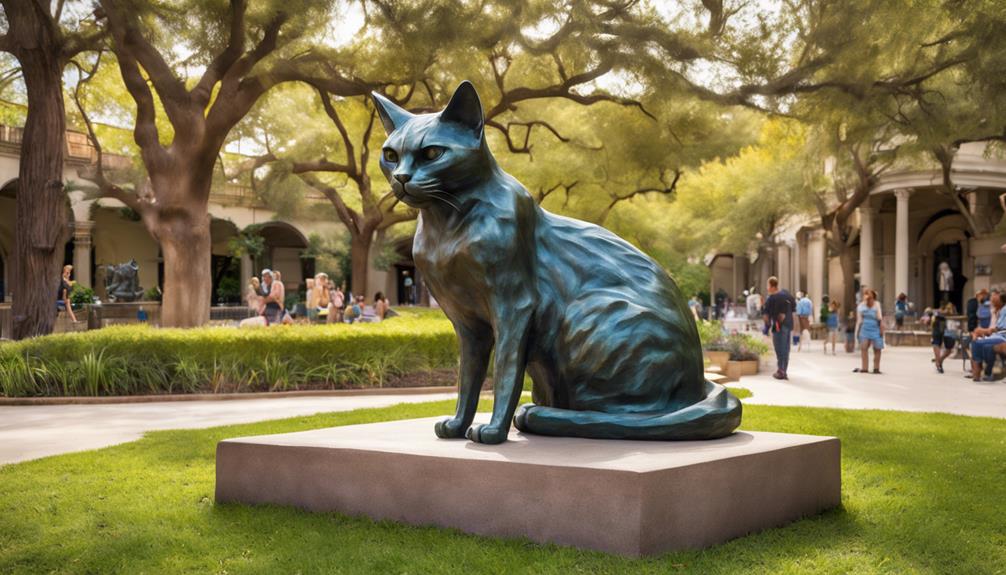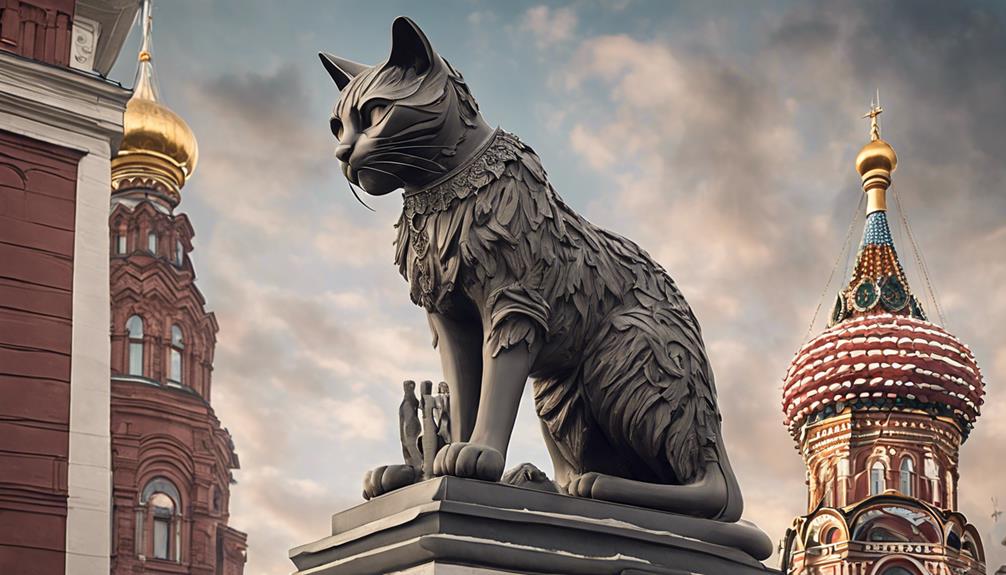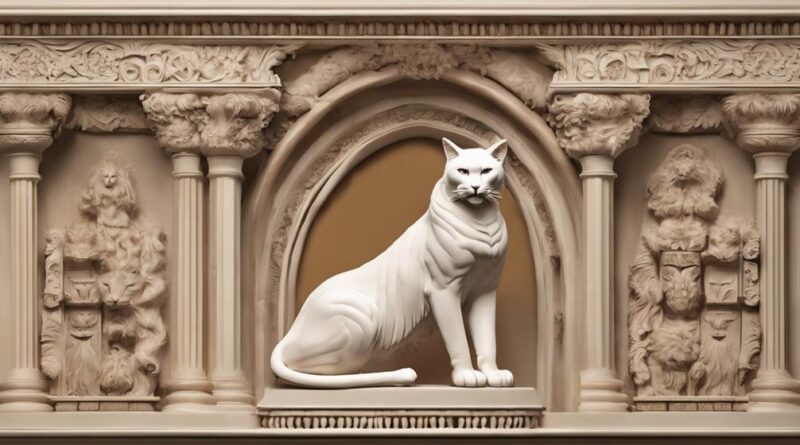12 Historic Monuments Celebrating Feline Majesty
Step into a world of feline grandeur with 12 historic monuments worldwide celebrating the majesty of cats. From the iconic Great Sphinx of Giza in Egypt symbolizing divine rulership, to the Bastet Temple honoring the feline goddess, each monument showcases the cultural significance of cats. Explore the Cat Alley in Ypres, Belgium, with its folklore and historic buildings, or visit the Cat House in Latvia, a symbol of defiance. Discover the Kuching Cat Museum in Malaysia and the Cat Boat in Amsterdam, offering unique feline experiences. These monuments reflect the admiration and importance of cats across diverse cultures.
The Great Sphinx of Giza
Standing proudly in the desert sands of Egypt, the Great Sphinx of Giza has captivated visitors for centuries with its enigmatic gaze and majestic presence. This iconic limestone statue, with the body of a lion and the head of a pharaoh, stands as a symbol of ancient Egyptian civilization's strength and wisdom. The Great Sphinx represents the Pharaoh Khafre, believed to be the builder of the Second Pyramid at Giza, and embodies the fusion of human intelligence and animalistic power.
The Great Sphinx's symbolic representation goes beyond its physical attributes. It's a testament to the Egyptians' belief in the divine rulership of their pharaohs, who were considered to be earthly manifestations of gods. The monument's positioning facing the sunrise has led to interpretations linking it with solar worship and the cycles of life and death. Moreover, the Sphinx's location near the pyramids suggests a connection to the afterlife and the journey of the soul.
Mysteries surrounding the Great Sphinx have intrigued historians and archaeologists for generations. From the debate over its original purpose to the various restoration efforts over the years, the monument continues to reveal new insights into ancient Egyptian culture and engineering prowess. Recent studies using advanced technology have unveiled hidden chambers and passages within the Sphinx, shedding light on its construction and possible additional meanings. The Great Sphinx stands not only as a symbol of the past but also as a gateway to unlocking the mysteries of ancient Egypt.
Bastet Temple in Egypt
The Bastet Temple in Egypt, dedicated to the revered feline goddess Bastet, stands as a testament to ancient Egyptian devotion to their beloved deity. Bastet, often depicted with the head of a lioness or domestic cat, held significant influence in ancient Egyptian society. She was revered as a protector of the home, guardian of the pharaoh, and symbol of fertility.
Feline symbolism permeated the temple's architecture and artifacts, emphasizing the sacred nature of cats in Egyptian culture. Statues of cats adorned the temple grounds, underscoring their association with Bastet and the divine realm. Ancient rituals conducted within the temple precincts showcased elaborate ceremonies honoring the feline goddess, highlighting the deep spiritual connection Egyptians had with their feline companions.
Despite the passage of millennia, Bastet's influence endures in modern worship practices. Devotees still pay homage to Bastet, seeking her blessings for protection, fertility, and prosperity. The legacy of the Bastet Temple serves as a reminder of the profound bond between ancient Egyptians and their feline goddess, resonating with cat lovers and historians alike. As you stand amidst the ruins of the Bastet Temple, you can feel the echoes of ancient rituals and the enduring power of feline majesty in Egyptian culture.
Cat Alley in Ypres, Belgium
Amidst the charming cobblestone streets of Ypres, Belgium, Cat Alley beckons visitors with its unique blend of history and feline allure. As you stroll through this narrow passageway, surrounded by buildings that date back centuries, you can feel the whispers of feline folklore and admire the intricate details of Ypres architecture.
- Feline Statues: At every turn in Cat Alley, you encounter statues of elegant cats perched on windowsills or prowling along rooftops. These sculptures pay homage to the mysterious and revered role that cats have played in folklore and mythology throughout history.
- Historic Buildings: The architecture surrounding Cat Alley is a testament to Ypres's rich past. From Gothic spires to Baroque facades, each building tells a story of the city's evolution over the centuries. The juxtaposition of these historical structures with the whimsical cat-themed decorations creates a truly enchanting atmosphere.
- Cat-themed Artwork: As you wander through Cat Alley, you'll notice an array of cat-themed artwork adorning the walls. Vibrant murals depict scenes of cats engaged in various activities, adding a playful touch to the alley's ambiance. These artistic expressions serve as a reminder of the enduring fascination that felines have inspired in humans throughout the ages.
Kuching Cat Museum in Malaysia
In the realm of feline admiration and historical exploration, the Kuching Cat Museum in Malaysia stands as a fascinating tribute to the beloved and enigmatic creatures. This museum, located in the city of Kuching on the island of Borneo, is a unique establishment that showcases cat-themed architecture and holds significant cultural value. The museum's design itself is a sight to behold, with cat motifs adorning the building's exterior and interior, making it a remarkable example of cat-themed architecture.
As a popular tourist attraction, the Kuching Cat Museum attracts visitors from all over the world who come to marvel at its quirky and charming exhibits. From cat artifacts and memorabilia to artworks depicting cats in various forms, the museum offers a comprehensive look at the historical and cultural significance of cats in Malaysia and beyond. It serves as a hub for cat lovers and enthusiasts, providing a space for education and entertainment centered around these fascinating creatures.
Moreover, the Kuching Cat Museum plays a crucial role in historical preservation by documenting and showcasing the relationship between cats and humans throughout the centuries. By highlighting the impact of cats on different cultures and societies, the museum contributes to the understanding and appreciation of these animals in a way that's both informative and engaging. For anyone with an interest in feline history and culture, a visit to the Kuching Cat Museum is a must-see experience that promises to be both enlightening and entertaining.
The Cat Boat in Amsterdam
Nestled along the serene canals of Amsterdam, lies the Cat Boat, a unique floating sanctuary for feline companions. The Cat Boat, officially known as 'De Poezenboot,' is a houseboat turned cat shelter that has been a purr-fectly charming Amsterdam attraction for over five decades. Here's what makes this floating haven for cats so special:
- Floating Felines: The Cat Boat provides a safe and loving environment for homeless and stray cats. These floating felines enjoy the cozy nooks and crannies of the houseboat, complete with scratching posts, toys, and sunny spots for catnaps. Visitors can interact with the cats and even inquire about adoption, making it a unique experience for cat lovers and those looking to give a furry friend a forever home.
- Unique Architecture: The Cat Boat's architecture is a blend of functionality and whimsy. The houseboat is divided into different areas to accommodate cats with varied temperaments, ensuring they all feel comfortable and secure. The colorful exterior and cat-themed decorations add to the charm of this one-of-a-kind shelter, creating a visually appealing space that reflects the love and care given to its inhabitants.
- Purr-fectly Charming Amsterdam Attraction: Beyond its role as a cat shelter, the Cat Boat has become a beloved tourist destination in Amsterdam. Cat enthusiasts and curious travelers flock to the canals to visit this iconic floating sanctuary, immersing themselves in the unique atmosphere and maybe even finding a new furry friend to adore.
The Cat House in Latvia
With its enigmatic facade and intriguing history, the Cat House in Latvia stands as a symbol of feline-inspired architectural marvels in Riga. This unique building, located in the heart of the Latvian capital, is a prime example of cat themed architecture that holds great cultural significance.
Constructed in the early 20th century, the Cat House is renowned for its striking feline sculptures perched on the rooftop, which are said to symbolize defiance towards the Great Guild, a neighboring establishment that once rejected the homeowner's bid for membership. The intricate details of the sculptures, from their arched backs to raised tails, add to the mystique of the building and attract visitors from around the world.
Beyond its architectural charm, the Cat House serves as a reminder of the rich history and cultural heritage of Riga. It represents a time when art and symbolism were intertwined in everyday life, showcasing the importance of creativity and expression in architecture. The Cat House stands as a testament to the enduring legacy of cat symbolism in Latvian culture and continues to be a beloved landmark in the city.
The Cat Statue of San Antonio

The Cat Statue of San Antonio commands attention in the heart of the city, a tribute to feline grace and charm. This artistic masterpiece stands tall, symbolizing the deep-rooted connection between the people of San Antonio and their love for cats.
- Cultural Significance: The Cat Statue of San Antonio holds immense cultural significance as it represents the city's admiration for cats, which are often seen as mysterious and elegant creatures in various cultures worldwide. The statue's presence not only adds to the aesthetic appeal of the city but also serves as a symbol of respect for the feline species.
- Artistic Design: The intricate artistic design of the statue showcases the craftsmanship and creativity of the sculptor. Every detail, from the cat's whiskers to its posture, is meticulously crafted to capture the essence of these beloved animals. The lifelike representation of the cat evokes a sense of wonder and appreciation for the art form.
- Local Folklore, Community Impact: According to local folklore, it's believed that the Cat Statue of San Antonio brings good luck to those who rub its nose. This superstition has become a cherished tradition among both residents and visitors, fostering a sense of unity and community spirit. The statue has become a beloved landmark, attracting cat enthusiasts and art aficionados alike, further solidifying its place in the hearts of the people of San Antonio.
Tashirojima Island in Japan
Amidst the tranquil waters of the Pacific Ocean lies Tashirojima Island in Japan, a haven where feline inhabitants roam freely among lush landscapes and traditional architecture. Known as Cat Island, this unique destination has garnered significant attention from tourists worldwide due to its unusual feline population. The island's cat-friendly environment and the cultural significance attributed to cats in Japanese folklore have contributed to its charm and popularity.
Tashirojima Island's feline population isn't just a random occurrence but is deeply ingrained in the island's history and culture. Cats were originally brought to the island by fishermen to control the rodent population that threatened silkworms, a vital resource for the local silk industry. Over time, the cats became revered and cared for by the island's residents, who believed that feeding and looking after the cats brought them good luck and fortune.
Today, Tashirojima Island attracts cat enthusiasts and curious travelers who are eager to experience the unique cohabitation of humans and cats. Tourism has flourished on the island, with visitors enjoying cat-themed accommodations, cat-shaped cabins, and the opportunity to interact with the friendly feline residents. As one explores the island's picturesque scenery and interacts with its furry inhabitants, the deep-rooted cultural significance of cats in Japanese society becomes apparent, making Tashirojima a truly remarkable and unforgettable destination for cat lovers.
The Cat Monument in Russia

In Russia, a remarkable tribute to feline majesty stands tall in the form of the Cat Monument, captivating visitors with its unique representation of the revered creatures. This monument holds a significant place in Russian culture, reflecting the deep-rooted connection between the people of Russia and their admiration for cats.
- Symbol of Protection: The Russian cat monument symbolizes protection in feline folklore, where cats were believed to ward off evil spirits and bring good luck to households. This representation of cats as protectors highlights the reverence and significance these animals hold in Russian society.
- Historical Significance: The intricate details and craftsmanship of the Russian cat monument pay homage to the historical importance of cats in Russia. Throughout centuries, cats have been cherished for their role in controlling pests and safeguarding grain supplies, making them indispensable companions to the Russian people.
- Cultural Resonance: The Cat Monument in Russia serves as a cultural touchstone, embodying the essence of feline folklore and its enduring influence on Russian traditions. Visitors are drawn to this monument not only for its artistic value but also for the profound cultural significance it represents in celebrating the majesty of cats in Russian society.
The Cat Museum in Italy
Nestled within the vibrant streets of Italy, discover a captivating Cat Museum that delves into the rich history and cultural significance of felines in Italian society. This museum serves as a hub for understanding the deep-rooted connection between cats and the Italian people, showcasing their cultural significance through artistic representation.
The Cat Museum in Italy stands as a symbol of historical preservation, housing a plethora of artifacts, paintings, and sculptures that highlight the revered status of cats throughout different periods in Italian history. From ancient Roman times to the Renaissance era, these artistic representations not only celebrate the beauty of felines but also shed light on their roles as companions, protectors, and even divine symbols in Italian culture.
Moreover, the museum's impact on tourism can't be understated. Visitors from around the world flock to this unique establishment to immerse themselves in the world of Italian feline admiration. The Cat Museum not only attracts cat enthusiasts but also history buffs and art lovers alike, contributing significantly to the local economy and cultural exchange.
In essence, the Cat Museum in Italy stands as a testament to the enduring charm and influence of cats in Italian society, offering a fascinating journey through the intertwined narratives of art, history, and cultural heritage.
The Cat Village in Taiwan

The Cat Village in Taiwan provides a captivating glimpse into a community where feline companionship intertwines with cultural traditions and local charm. Nestled amidst lush greenery, this village has become a haven for cat lovers and enthusiasts from around the world. Here, you can witness the harmonious coexistence between humans and cats, where these elegant creatures roam freely, adding a touch of whimsy to daily life.
- Cat Cafe: One of the highlights of the Cat Village is the charming cat cafe where visitors can enjoy a cup of tea or coffee in the company of friendly felines. This unique concept not only promotes relaxation but also fosters a deeper connection between humans and cats, enriching the overall experience.
- Cultural Impact: The presence of cats in the village has significantly influenced local art, cuisine, and traditions. From cat-themed souvenirs to special dishes inspired by these beloved animals, the cultural impact of the feline residents is palpable throughout the community.
- Conservation Efforts, Community Involvement: The Cat Village isn't just a tourist attraction; it's also actively involved in conservation efforts to protect stray and abandoned cats. The community works together to provide food, shelter, and medical care for these animals, showcasing the power of collective action in creating a more compassionate society.
The Cat Palace in Istanbul
Have you ever wondered about the regal feline legacy embodied by the Cat Palace in Istanbul, where history and majesty converge in a captivating display of cultural significance? The Istanbul Cat Palace, also known as the Cat Museum, stands as a testament to the deep-rooted connection between the people of Istanbul and their beloved feline companions. This architectural marvel, located in the heart of the city, serves as a homage to the rich feline history that has woven its way through Istanbul's streets for centuries.
The Istanbul Cat Palace isn't merely a structure but a sanctuary for all things cat-related. From ancient artifacts depicting cats in various forms to interactive exhibits detailing the role of cats in Turkish folklore and superstitions, this palace is a treasure trove for feline enthusiasts and history buffs alike. As you wander through its corridors, you'll encounter sculptures, paintings, and memorabilia celebrating the revered status of cats in Turkish culture.
Moreover, the Istanbul Cat Palace offers a glimpse into the lives of the city's stray cats, showcasing how these animals have become an integral part of Istanbul's urban landscape. Through its exhibits and educational programs, the palace aims to raise awareness about the importance of animal welfare and the need to protect and cherish these furry inhabitants of Istanbul. Visit the Cat Palace in Istanbul, and immerse yourself in a world where feline grace and cultural heritage intertwine in a truly majestic setting.
Frequently Asked Questions
Are There Any Live Cats Residing in These Historic Monuments?
Yes, live cats may reside in historic monuments. These feline residents often bring charm and life to these iconic places. They can be found roaming the grounds or lounging in sunny spots, adding a unique touch to the monument's atmosphere.
Visitors enjoy spotting these furry inhabitants, and caretakers ensure they're well taken care of within the monument's walls. Their presence adds an extra layer of historical and cultural significance to these sites.
Can Visitors Interact With the Cats at These Locations?
Visitors can interact with the feline ambassadors at these locations, fostering a unique experience. Engaging with the cats can create memorable moments and add to the overall charm of the historic monuments.
These interactions often bring joy to both visitors and the feline residents, creating a special bond between humans and our furry friends. Embracing these opportunities can enhance your visit and allow you to appreciate the significance of these majestic creatures in historical settings.
Is There a Specific Reason Why Cats Are Celebrated in These Monuments?
Cats are celebrated in these monuments due to their cultural significance and historical representation. Throughout history, felines have held a special place in various societies, symbolizing traits like grace, mystery, and independence.
These monuments pay homage to the enduring fascination and reverence people have for cats. By immortalizing them in stone, art, or architecture, these structures serve as lasting reminders of the deep connections between humans and these enigmatic creatures.
Do These Monuments Have Any Special Events or Ceremonies Dedicated to Cats?
Do these monuments hold special events or ceremonies for cats? Some sites indeed host ceremonial rituals and cat-themed festivals to honor feline majesty.
These events often attract cat lovers from far and wide, celebrating the unique bond between humans and their feline companions. Attendees can partake in various activities, such as cat parades, costume contests, and educational talks about cat history and behavior, making these events a purrfect celebration of all things feline.
Are There Any Superstitions or Legends Associated With the Cats at These Sites?
Superstitions, folklore, myths, and legends often swirl around the cats inhabiting these sites. Cultural significance and historical importance intertwine with tales of mystical powers, luck, and guardian spirits attributed to these feline creatures.
The locals share stories of how these cats bring prosperity, protect the monuments from harm, and connect the past with the present through their mysterious presence. These beliefs add a layer of enchantment to the already majestic atmosphere of these historic sites.
Conclusion
As you journey through these 12 historic monuments celebrating feline majesty, you're immersed in a rich tapestry of culture, history, and reverence for our beloved feline friends.
From the ancient wonders of Egypt to the quirky Cat Boat in Amsterdam, each monument tells a unique story of the special bond between humans and cats throughout the ages.
These monuments serve as a reminder of the enduring legacy and significance of cats in our world.
